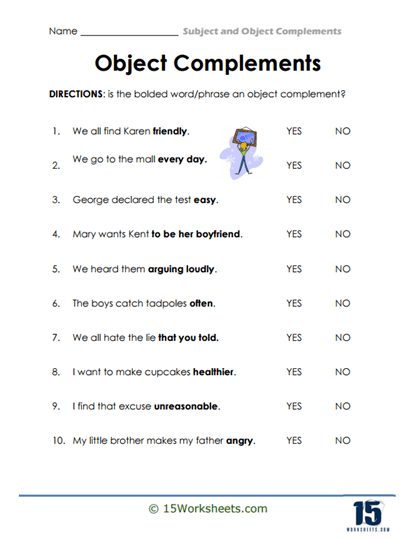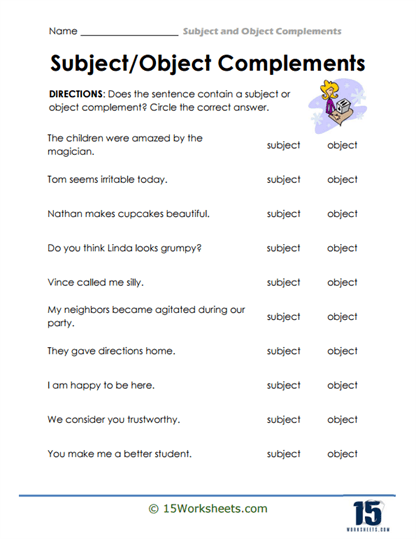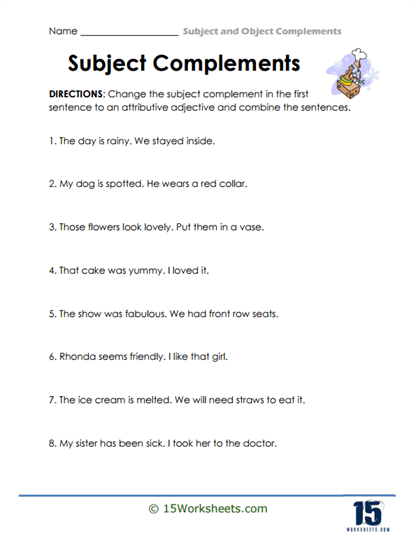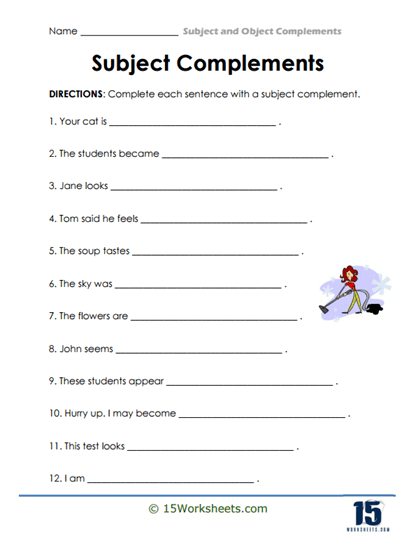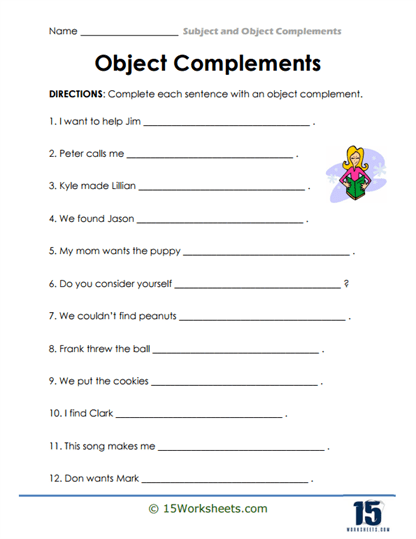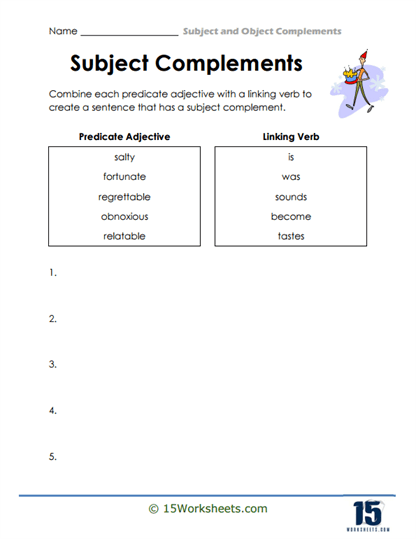Subject and Object Complements Worksheets
About These 15 Worksheets
This series of worksheets provides an essential toolkit for teaching students the nuances of sentence structure, particularly in understanding how subject and object complements function within a sentence. These worksheets are designed to support students, teachers, and homeschoolers by offering a variety of exercises that cater to different learning styles and levels of comprehension. Each worksheet in this collection is available in PDF format, making it convenient for educators to view, download, and print them for classroom use or home study.
The first set of worksheets focuses on subject complements, which are critical for completing the meaning of a sentence that includes a linking verb. These exercises require students to identify subject complements by underlining them in sentences, determining whether a bolded word functions as a subject complement, and writing sentences using specific types of subject complements. By practicing these activities, students gain a clearer understanding of how words like adjectives, nouns, and prepositional phrases can serve as subject complements, providing essential information about the subject of the sentence.
Another key component of this collection is the set of object complements worksheets. These activities introduce students to object complements, which come after a direct object and provide additional information about it. Through exercises that involve completing sentences with the appropriate object complements, students learn to recognize and properly use these complements, enhancing their overall sentence construction skills. These worksheets challenge students to think critically about the relationships between the components of a sentence and how object complements help clarify and specify the action being described.
In addition to identifying and writing complements, this collection includes worksheets that combine both subject and object complements, helping students understand the distinctions between the two and how they function together within a sentence. True or false questions and sentence completion activities further solidify these concepts, ensuring that students not only identify complements but also apply them correctly in their writing.
To complement the foundational exercises, the collection features more advanced activities that require students to rewrite sentences by changing complements or creating complex sentences that incorporate both subject and object complements. These higher-level tasks are designed to push students’ understanding and encourage them to use complements creatively and effectively in their writing. These activities help students develop the skills needed for more sophisticated sentence structures and enhance their ability to communicate clearly and precisely.
This comprehensive collection also has additional activities that would further support the learning of subject and object complements. For example, worksheets could include activities where students identify and correct errors in sentences involving complements, or more interactive exercises such as sentence diagramming, which visually represents the structure of a sentence, including its complements. These additional types of worksheets cater to different learning preferences and deepen students’ understanding by providing varied methods of practice and reinforcement.
By engaging in these varied activities, students not only learn to identify and use complements but also develop a deeper understanding of sentence structure and how different parts of a sentence work together to convey meaning. These worksheets are an invaluable tool for any teacher or homeschooler looking to enhance their students’ writing and grammatical skills.
What Are Subject and Object Complements?
Subject and object complements are key components in sentence structure that serve to complete the meaning of the subject or object in a sentence. These complements provide additional information about the subject or object, making the sentence clearer and more specific. Understanding how these complements function is crucial for constructing sentences that are both grammatically correct and effectively communicate the intended message.
A subject complement follows a linking verb and provides more information about the subject of the sentence. Linking verbs, such as “is,” “seems,” “becomes,” and “appears,” connect the subject to the complement, which can be a noun, pronoun, or adjective. For example, in the sentence “The sky is blue,” the word “blue” is a subject complement because it describes the subject, “the sky.” Similarly, in “She became a teacher,” “a teacher” is a noun phrase functioning as the subject complement, explaining what “she” became. Subject complements are essential because they complete the meaning of the subject, helping to answer questions like “What is the subject?” or “What state or condition is the subject in?”
On the other hand, an object complement follows a direct object and provides more information about that object, often answering questions like “What did the object become?” or “How did the object end up?” Object complements are usually found after verbs that require an object, such as “make,” “consider,” “name,” or “elect.” For instance, in the sentence “The committee elected Sarah president,” the word “president” is an object complement because it tells us what Sarah was elected as. Similarly, in “They painted the house red,” “red” serves as the object complement, describing the state of the house after the action of painting.
The purpose of subject and object complements in grammar is to provide clarity and completeness to sentences. Without these complements, sentences with linking verbs or certain action verbs would feel incomplete or vague. For example, the sentence “The sky is” leaves the reader wondering what about the sky is being discussed. Adding the complement “blue” gives the sentence a clear and complete meaning. Similarly, “They made the room” would be an incomplete thought, but adding the complement “tidy” completes the idea and clarifies what was done to the room.
Understanding subject and object complements is also important for avoiding common grammatical errors. For instance, mistaking an object for a subject complement or vice versa can lead to incorrect sentence structures. Properly identifying these complements helps in forming sentences that are not only grammatically correct but also more expressive and nuanced. This understanding also enables writers and speakers to craft more complex and interesting sentences by effectively using complements to add detail and depth.






